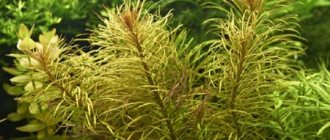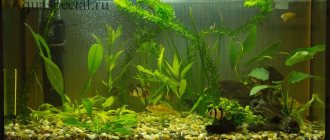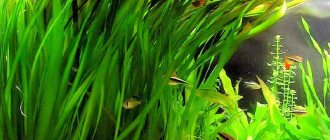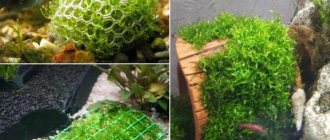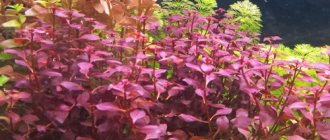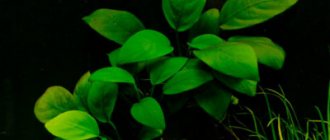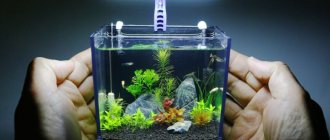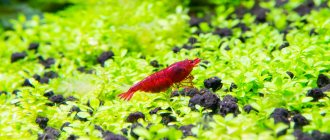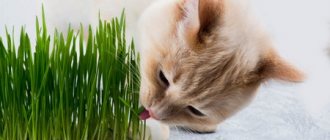What are decorative mosses?
Aquarium decorative mosses are inhabitants of a huge plant kingdom.
They differ significantly from lichens and algae in several factors:
- they have shoots, leaves;
- reproductive organs are present;
- with the correct cycle, they can develop into 2 morphological generations: sporophyte, gametophyte.
There are also distinctive features of mosses relative to higher plants:
- in mosses, the sporphyte is attached to the gametophyte;
- no root system.
Benefits of using mosses in home ponds
- Mosses are simple plants, so they easily adapt to any habitat and do not require special care.
- Mosses were classified as unpretentious plants. They don’t care what kind of lighting and its brightness, whether there are fertilizers in the water. They receive all the necessary substances from the environment, absorbing them throughout the surface.
- Their slow growth allows you to maintain a beautiful composition longer.
- Mosses make the aquarium more natural.
- Some mosses die off, while others grow. This occurs due to plant reproduction by spores.
- They serve as a good refuge for fry and fish, and aquarium moss also serves as a secluded place for spawning.
PLANTS FOR MODERATELY WARM AQUARIUM
Plants for a moderately warm aquarium
Plants for a moderately warm aquarium are available in a fairly wide and varied selection.
On the one hand, many cold-water plants can withstand elevated temperatures in the aquarium for a long time if they are accustomed to this (coin, ludwigia, water moss, riccia, calamus and arrowhead).
On the other hand, many warm-water plants can be cultivated in a moderately warm aquarium, such as bladderwrack, some species of aponogeton, hygrophila, bluenama, Carolina cabomba and some other species.
Here we will describe only a few plants that are especially suitable for a moderately warm aquarium.
Toothed elodea
(Elodea densa) - a beautiful bright green fast-growing plant; looks especially good in a bush. It can live rooted in the ground or in a free-floating state. Propagated by lateral shoots; A new plant can be grown from any part of the stem. With sufficient lighting, which she loves very much, serrated elodea produces a lot of oxygen. In a poorly lit aquarium it dies quickly.
Lagarosiphon
(Lagarosiphon muscoides) - comes from Africa. It is closely related to the previous species and requires the same conditions of detention.
Vallisneria
(Vallisneria spiralis; form with spirally twisted leaves. V. spiralis forma fortifolia, called spiral-leaved) - distributed in almost all warm regions of the globe. It takes root in the ground and reproduces by means of its mustache. Vallisneria loves good light, but not strong sunlight.
Heteranthera
(Heieranthera zosteraefolia) - comes from South America. Roots in the ground, propagates by lateral shoots and cuttings. Looks especially good if it forms small bushy thickets.
Dwarf Amazon
(Echinodorus intermedius). Homeland - South America. An extremely unpretentious plant, content with even low light and tolerating large temperature fluctuations. Depending on the conditions of detention, it forms various forms. Roots in the ground; propagates by tendrils that can be separated from the plant.
Types of mosses living in aquariums
Mosses come in three classes. Experts conducted a number of studies that helped assign them a classification:
- Anthocerotaceae . These mosses deserve their name due to the presence of lamellar thalli. Their origin began in places with a slightly hot climate and in the tropics;
- Liverworts . Outwardly they look delicate and small. Most often in aquariums, floating riccia is used. Previously, only Java moss and fontinalis were used for breeding in home aquariums (in addition to Richia). They were planted in spawning areas;
- Leafy . The class has the largest number of plants, so it is divided into 3 subspecies:
- Brieves.
- Sphagnum.
- Andreevs.
Over the years, scientists have discovered many more varieties of aquarium mosses that can survive in an aquarium and become beautiful decorations.
Conditions for breeding
All types of mosses require almost the same conditions. Even if there are no plants of other species in the aquarium, moss will be an excellent alternative for decoration.
The main conditions for creating beautiful compositions:
- The water temperature should be 20−25 ° C. Many species can tolerate higher temperatures, but at the same time they can stop growing and then begin to rot.
- The water hardness should not be too high, but not too low. Many species will not survive in hard water, and in soft water they will turn yellow.
- Lighting can be bright, as lots of light causes moss to grow faster.
- Carbon dioxide is necessary for good growth, but the simplest types of aquarium moss grow without it. But rare and decorative species need carbon dioxide, so care must be taken to supply it artificially.
- Micro and macroelements should be added when absolutely necessary, as some nitrates benefit some plants but harm others. Phosphorus, calcium and copper are suitable for all types of mosses.
- There must be soil in the aquarium. It plays a very important role for all inhabitants, because it supports the vital activity of beneficial bacteria.
- It is necessary to keep the aquarium clean and remove all debris in a timely manner.
- Overgrown branches need to be removed, because new shoots shade the lower ones, and this leads to the death of the latter.
In general, caring for and maintaining these plants does not bring much inconvenience and does not take much time. And compliance with all maintenance conditions will make the aquarium more beautiful.
https://youtube.com/watch?v=XtvxxUy-6qA
Floating Riccia
This type of mossy plants is the most popular, because it has captivated home aquarium owners with its unpretentiousness. Externally, the plant does not have a very impressive appearance, but it has some advantages:
- Used as a floating or underwater aquarium plant.
- Makes an excellent soil crop when kept in a terrarium.
- It is a wonderful place for a fish refuge or to build a nest.
The most important function of Riccia is its influence on the microclimate of the home pond, due to the circulation of substances within it.
Riccia is widespread in nature, because over time it began to migrate using the bird’s feet, it sticks to them, and the bird carries the plant to another body of water. Next, Riccia quickly adapts to the new area and begins to actively grow.
Appearance of floating riccia. This plant consists of small branching plates, closely intertwined with each other. If Riccia forms a so-called carpet, then it can reach several centimeters in thickness, and aquarium moss will also have high strength. The normal color of algae is green, but if it starts to turn reddish, then its location is unfavorable.
Parameters for growing floating riccia in an aquarium
Like many plants, floating riccia needs to be provided with at least minimal conditions for its maintenance. Thanks to them, the plant will grow healthy and have a rich color. To do this you need to pay attention to:
- Optimal water parameters.
- Lighting.
- Reproduction.
Optimal water parameters . The temperature of the liquid in the aquarium should be 22-28 ℃. Of course, the plant can withstand both 15℃ and 30℃, but this can make Riccia sick. For these algae it is better to use a neutral, soft liquid. If the pH increases to 8, then the plant will slow down significantly in growth.
It is advisable to periodically change the fluid in an amount of 1/5. This should be done once every 2 weeks.
Lighting . The color of the plant depends on this factor, so it is recommended to install a bright fluorescent lamp with a distance of at least 10 cm between it and the liquid.
Reproduction of floating ricci occurs vegetatively. For new plants to appear, even a small piece of algae is enough, which can form a new, luxurious carpet. However, it is better to prevent the growth of riccia from thickening, and regularly remove excess shoots.
If the aquarist decides to keep the plant in the water column, then it needs to be attached to the ground, sprinkled with fertilizers and increased saturation of the home reservoir with CO2.
How to attach moss to driftwood?
Aquarium mosses are ideal for creating compositions on roots or rocks in the aquarium. The driftwood should be covered with small tufts of moss, which should grow at a rapid pace. Aquarium mosses have a very poor root system, so it is worth attaching newly acquired moss to driftwood using fishing line or thread. When the moss grows, the fishing line will no longer be visible. Moss can also be placed in a nylon mesh that will cover a decorative element or the back wall of the aquarium .
ARTIFICIAL PLANTS FOR AQUARIUM - HOW TO PREPARE THEM SO THAT THEY LOOK LIKE REAL?
PLANTS FLOATING IN THE AQUARIUM. WHICH IS BETTER TO CHOOSE?
DISEASES OF AQUARIUM PLANTS AND THEIR CAUSES
Riccardia
Riccardia is a hepatic, creeping plant, no more than 4 cm high. Its origin came from Taiwan, and is now widespread in Southeast Asia. In the assortment of stores you can see up to 5 variants of this moss, because it has about 300 varieties.
For comfortable maintenance of riccardia, the following conditions will be required:
- suitable water temperature;
- filtration;
- substrate;
- lighting.
The water temperature for ricardia should not exceed 18-24℃. With prolonged overheating, the plant may die, and hardness and acidity do not matter to it.
Riccardia needs good filtration. Without it, the plant is able to absorb detritus.
A substrate for riccardia is needed in the form of driftwood, stones, and porous ceramics. If you have just purchased moss, you will need to temporarily tie it to the ground with threads.
The light should be saturated, then the plant will delight with its green color. It is also recommended to add CO2.
Riccardia needs to be trimmed regularly. This is due to the fact that without pruning, the lower part of the plant will begin to rot, and the algae will be susceptible to rotting.
Java moss belongs to the Hypnaceae family, whose representatives are widely distributed in water bodies of the Eurasian continent. This family includes several hundred aquatic and amphibious mosses. But currently, only Java moss is kept in aquariums. Perhaps other representatives of this family have simply not yet come to the attention of aquarists, otherwise they, without a doubt, would very quickly gain popularity of Java moss.
Java moss (Vesicularia dubyana) first appeared in Russia in 1960. Externally, it is a chaotic dense interweaving of thin, highly branched stems, densely covered with dark green leaves 1-2 mm in size. In the underwater form, no other organ differences are observed. The plant includes only stems and leaves. The countless rhizoids with which moss can attach itself to almost any surface are too small to be seen with the naked eye.
The apparent randomness of the general form of Java moss is actually deceptive . If you attach a piece of the plant to a permanent place and do not touch it for several months, you may notice that the growth of the stems occurs differently. First, the stems stretch to the sides and down, hugging the substrate and providing a reliable connection to its surface. Then, having firmly attached itself, the plant produces a large number of shoots, directed horizontally and slightly upward, so that the entire mass of moss takes the form of numerous layers with an arched arrangement relative to each other. And finally, after the plant has gained a sufficient amount of biomass, stems of the third type begin to grow, directed clearly upward. If you allow them to reach the surface of the water in the aquarium, you will eventually be able to observe the sexual reproduction of the Java moss. Black shoots, so-called sori, bearing dark brown capsules with spores at the ends will appear on the above-water stems. Ripe spores fall into the water. Some of them grow into a bright green thread-like protonema, which gives rise to a new plant. But, it should be noted that all this is possible only if there is no strong current in the aquarium, no fish disturbing the plant, and the aquarist himself will not interfere with the natural course of the plant’s development.
The above-water (photo on the left) and underwater (photo on the right) forms of vesicularia of Java moss differ significantly from each other
Java moss also grows well in a greenhouse or conservatory . After appropriate adaptation, the plant successfully lives at a humidity of 60-70%; only occasional spraying is sufficient. The above-water form of Java moss, bright green in color, looks more attractive than the underwater form. Periodic keeping outside the aquarium is beneficial for Java moss, since it gets rid of algal fouling that tends to affect it in the aquarium.
Java moss is one of the most unpretentious plants to keep in an aquarium . The characteristics of the water do not matter to him. The plant tolerates a very wide range of pH and hardness values. Java moss is even capable of withstanding a salinity of 2-3‰ for a long time. The plant does not have any special requirements for lighting. Java moss can survive for months in dark aquariums where no other aquatic plant can survive. When maintaining Java moss, no fertilizers are required, either in the soil or in the water. Java moss reacts to all life's adversities only by slowing down its growth and slightly darkening its color.
When placed in favorable conditions - in bright light and in water with a neutral or slightly acidic reaction, it would be nice to be enriched with peat decoction or a preparation of tropical black water - then Java moss grows very quickly and acquires a stunning emerald color.
Java moss in an aquarium can be used in two forms: utilitarian and decorative . The first case is, first of all, its use in fish breeding. It is a favorite substrate for spawning of many phytophilic fish, very favorable due to its sponge-like structure and because of its specific gravity heavier than water, so that it often does not even require any fixation in the spawning tank. Fish like Java moss; this has long been noticed by fish breeders.
In many amateur decorative aquariums, frequent spontaneous spawnings of various fish, mainly characins and cyprinids, as well as iris, occur. Usually this caviar is devoured by neighbors. But if there is Java moss in the aquarium, part of the eggs remains and develops into fry, which also find shelter and food in dense thickets of moss. They create a very favorable biological environment, with good oxygen saturation and various microorganisms, primarily ciliates, which serve as the first food for the fry. At different times, barbs (Puntius ticto and Puntius titteya), rasboras (Rasborapauciperforata), tetras (Moenkhausia pittieri), roadsias (Rhoadsia altipinna) and many other species multiplied in this way. And for the fry of viviparous fish, the interweaving of Java moss is simply paradise.
Decorated aquariums containing large amounts of Java moss can be used to breed certain fish species on a fairly large scale. For example, almost all types of rainbow fish. The same applies to some species of egg-laying carp-toothed fish, which lay their eggs on plants. In aquariums with fish of these species, Java moss is practically “clogged” with fertilized eggs. It is enough to transfer the moss with eggs into a separate incubator aquarium at certain intervals, replacing it with fresh one.
Another unexpected use of Java moss in fish breeding was found by Moscow aquarist Mikulin A. It is known that when breeding many fish, due to increased requirements for the sterility of the spawning tank, living plants are not suitable as a substrate. Through a certain chemical treatment, the aquarist ensured that Java moss, while maintaining its structure and attractiveness for spawning fish, becomes absolutely sterile and can be used as a substrate. In addition, moss processed according to A. Mikulin’s method can be stored for a long time without loss of quality.
The use of Java moss for decorating an aquarium is very diverse . The most effective way is Java moss on driftwood or stones.
We lay out a thin layer of moss on a piece of driftwood prepared in a certain way and wrap it tightly with some kind of thread. Over the next few weeks, the moss grows to the surface of the driftwood and covers the bald spots. Our driftwood takes on a decorative appearance. Bolbitis or microzorium ferns, as well as anubias, are often planted with it. After some time, the plants grow, sprout into each other, representing a first-class example of an underwater landscape, while requiring practically no attention from the aquarist.
To grow onto driftwood, Java moss is carefully laid out on the surface of the driftwood in a thin layer and tied with a very thin fishing line or cotton thread. In the first days after strengthening on a snag, the new moss looks somewhat unsightly
These decorated driftwood are about a month old from the date of manufacture. This example clearly shows that the moss is still “tattered”, but is already beginning to take on a regular layered structure
For several years, such driftwood does not require alteration and only gets better from year to year. When decorating driftwood with Java moss, it is necessary to take into account several nuances: firstly, the moss should be spread over the surface of the base very thinly, almost twig to twig, avoiding dense lumps. Secondly, it must be wound tightly to the surface of the driftwood, without gaps. In this case, you can use a thin fishing line, which then needs to be removed, or you can use a cotton thread, which does not require removal. After a few weeks, the thread rots and falls apart on its own. In a similar way, you can decorate not only driftwood, but also any other objects.
This 100-liter aquarium was decorated with several pre-prepared driftwood with Java moss in almost ten minutes. He successfully lived for several years without changes and only got better and better
Another method of using Java moss in aquarium design is decorating the back walls of the aquarium . To do this, a coarse mesh made of thin fishing line is attached to the back wall of the aquarium, behind which moss is placed. In addition, anubias and ferns can be planted along the back wall. After some time, this wall will look very natural and beautiful.
You can decorate the bottom of the aquarium in a similar way. Java moss is laid between two layers of fine mesh and the edges are sewn together with fishing line. After some time, the plant will grow and completely hide the base. This is a fairly rarely used, but very effective technique.
As I mentioned above, aquatic mosses have been unfairly rarely used in aquarium keeping. Until recently, in addition to Java moss, only fontinalis could be found in this capacity. Collected from natural reservoirs, this moss has always been widely available for sale, but due to its cold water nature, it usually does not last long in indoor aquariums. Although there are known cases of its successful adaptation to higher temperatures, for example, in the Moscow club “Neptune”, famous in the second half of the last century.
For these reasons, a joyful event for Moscow connoisseurs of aquatic plants was the appearance several years ago of a new, third species of aquatic moss. Its specific name is still unknown. The plant probably belongs to the Fontinalis family. It is a small, bright green, fast-growing moss with excellent decorative properties. It is more light-loving than Java moss, and differs from it in the absence of rhizoids. Neither in an aquarium, nor in a greenhouse, its attachment to any substrate has ever been observed. The appearance of this plant in the domestic aquarium hobby is thanks to the famous collector Vladimir Kolesnik.
The composition of a new type of moss in combination with vesicularia and the “horned” form of the Thai fern looks very impressive. By the way, do you recognize the driftwood from the previous photo? This is her, only a few months later
Phoenix
Phoenix is a densely growing, fluffy, low-growing and beautiful plant with drooping feathers similar to the feathers of a magic bird. For this algae, the following conditions must be met:
- substrate;
- water temperature;
- cleanliness of the aquarium.
The substrate for the phoenix is nets, driftwood, stones. On such soil, the plant does not need to be tied.
The water temperature in the aquarium is 23-28 ℃, but does not die at a temperature of 15-30 ℃. The hardness of the liquid does not matter.
Cleanliness of the aquarium space must be mandatory. To achieve the desired sterility, it is necessary to replace 30-50% of the water.
The lighting of the aquarium should be as bright as possible. Thanks to this, it is possible to enhance the growth of the plant; it is advisable to use fertilizing.
Aquarium mosses - requirements and care
Aquarium mosses have low requirements, are generally easier to grow than other aquatic plants, and are a good proposition for beginning aquarists. Mosses tolerate weak sunlight well
, but it is important that access to light is uniform. We can grow them in aquariums along with floating aquarium plants that limit light access to the lower parts of the aquarium. Aquarium mosses also do not require additional fertilization. However, in order for the moss to grow well and look healthy, it is necessary to ensure that the aquarium is clean - otherwise the plant may become covered in algae and turn yellow.
Moss in an aquarium should be trimmed regularly
. This procedure enhances their growth and ensures uniform access to all branches. Thanks to pruning, we can give the moss any shape and form new plants from the resulting branches.
Aquarium mosses must also be desalinated - thanks to this, we will clean them of sediments and remove dead twigs. To do this, we can use special attachments or rinse the plants with water from the aquarium. Some aquarium fish, such as algae eaters and shrimp, are also very good at removing moss deposits.
Java moss
Java moss is a plant belonging to a small genus. On sale it can be seen in 10 varieties. This algae does not require special lighting, fertilizers, or feeding, but it is recommended to make the water neutral acidity 16-30℃.
Java moss has narrow, flattened shoots with lateral shoots and grows vertically. In home aquariums it can be seen in the background.
The disadvantage of Java moss is that it does not adhere to the ground, so it must be tied down.

